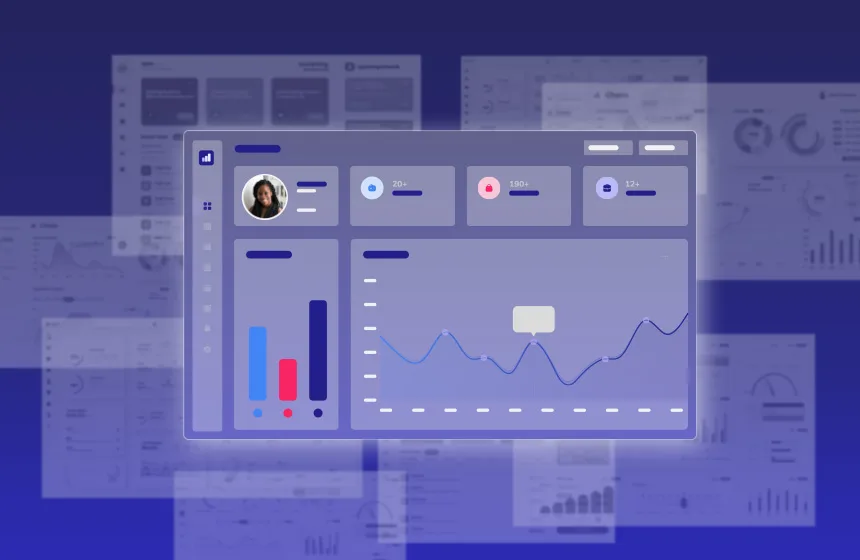Accelerate deals and increase win rates with the leading enterprise AI demo platform.
Navigate Like a Pro: The Essential Guide to Product Walkthroughs

April 23, 2025
Table of Contents
Representing a third of overall cloud spending, SaaS spend in the enterprise is predicted to rise to $195 billion in 2023. With so many enterprise SaaS products on the market, capturing and retaining the attention of users is a significant challenge. To address this, many enterprises turn to product walkthroughs as an effective way to guide users through their offerings.
This comprehensive guide will dive into the world of product walkthroughs, exploring their definition, benefits, practical applications, types, and step-by-step instructions on creating them. Whether you’re new to the concept or looking to enhance your existing product marketing strategy, this guide will equip you with the knowledge you need to create engaging and informative product walkthroughs.
What is a Product Walkthrough?
A product walkthrough is a user-friendly, step-by-step guide or interactive demo designed to help users navigate and understand a product or service. These walkthroughs can take various forms, from interactive guides, to video demonstrations, to click-through demos. The primary goal of a product walkthrough is to enhance the user experience, making it easier for users to unlock the full potential of a product, while minimizing frustration and confusion.
Benefits of a Product Walkthrough
Product walkthroughs offer a range of benefits that can significantly impact your business’s success. Here are some of their key advantages.
1. Increased User Engagement and Retention
Having an interactive product tour on your website can help you generate and convert leads. In fact, embedding Reprise demos on websites leads to a 60% uplift in average website interactions converted to leads. Why? Many users want to see a product for themselves before engaging with sales. Beyond your primary champion, enterprise buying committees can use these product walkthroughs to visualize how your product will work for their pain points and use cases.
Once your user is converted, user engagement is a vital metric for any product, as it directly impacts customer retention and lifetime value. Product walkthroughs play a pivotal role in boosting user engagement by providing a smooth introduction to your product’s features and functionalities. For prospects, a walkthrough can provide an essential first impression that engages them further in the sales process.
When users are introduced to your product through an informative walkthrough, they are more likely to explore further and discover the value it brings to their business. A well-crafted, interactive walkthrough can highlight unique features that users might overlook on their own, making the product more appealing and encouraging continued use.
Additionally, product walkthroughs can be used strategically to re-engage existing users. By periodically introducing new features or updates through walkthroughs, you can reignite interest and keep users invested in your product.
2. Improved User Onboarding Experience
Efficient onboarding is critical to retaining a user base. In fact, 86% of customers say they will remain loyal if onboarding and continuous education are provided. Walkthroughs streamline the onboarding process, helping users get started quickly and effectively, reducing the chances of abandonment due to frustration.
User onboarding is the critical phase during which users form their initial impressions of your product. A positive onboarding experience sets the stage for continued engagement, while a confusing or frustrating one can lead to high abandonment rates.
Product walkthroughs simplify the onboarding process by guiding users through the first steps and key features of your product. They provide clear instructions, reducing the learning curve and making it easier for users to get started. As a result, a higher percentage of users are more likely to achieve their desired outcomes quickly, leading to higher satisfaction and retention rates.
3. Personalized User Experience
Not all users are the same, and their needs and preferences can vary widely. To provide a personalized user experience, it’s essential to understand the specific requirements of different user segments.
Product walkthroughs can be tailored to cater to various user personas. By segmenting your audience and creating interactive walkthroughs that address the unique challenges and goals of each group, you can deliver a more relevant and engaging experience. This personalization fosters a sense of connection between active users and your product, increasing their loyalty and likelihood to advocate for your brand.
Now that we’ve explored the benefits of product walkthroughs, let’s move on to how to effectively use them in your product marketing strategy.
How to Use Product Walkthroughs
Product walkthroughs have versatile applications for different aspects of your business, including sales and marketing, onboarding, and user training. Interactive product tours can be an effective way to help users self-evaluate your product, or get new users deeply entrenched in the most valuable features for their use cases.
Sales and Marketing
Product walkthroughs are not only valuable for existing users, but also for prospects via your sales and marketing efforts. They can be used to showcase your product’s capabilities to potential customers throughout the enterprise sales cycle. Forrester research shows that 60% of buyers will go to a vendor’s website before accepting an online or in-person sales meeting. Featuring an interactive product walkthrough up front can enable prospects to self-qualify, making the sales process far more efficient.
Here are a few examples of elements you might incorporate for this use case:
- Demo Walkthroughs: Create interactive demos that simulate your product experience. That way, prospective clients can explore your product first hand before speaking with sales. Further on in the sales cycle, interactive demos can serve as leave-behinds for committee decision-makers, empowering your champions to tell your product story more effectively.
- Comparison Guides: Develop walkthroughs that compare your product’s core features with those of competitors. Highlight your unique selling points and explain why your solution is superior.
- Testimonials and Success Stories: Incorporate user testimonials and success stories within your walkthroughs to establish social proof. These narratives add credibility and demonstrate the value your product brings to similar businesses.
Onboarding
Product walkthroughs are a cornerstone of effective onboarding strategies. Onboarding new users successfully might involve the following components of a product walkthrough:
- Welcome Walkthrough: A welcome walkthrough greets users upon their first login. This walkthrough can introduce them to the product’s dashboard or main experience, explain key features, and guide them through the first steps with your product.
- Feature Highlights: These walkthroughs can explain specific valuable features or modules within your software. For instance, a project management software company might create a walkthrough focusing on task management, demonstrating how users can create, assign, and track tasks efficiently.
- Progress Tracking: Implement progress tracking in your walkthroughs to help users visualize their onboarding journey. Showing them how far they’ve come and what’s left to explore not only keeps users well informed, but also can make a product stickier.
Product Training
Product walkthroughs aren’t limited to onboarding; they can also be instrumental in providing ongoing product training. For more complex products, product training can empower your users with the necessary skills to become power users. Here are a few examples of how you might incorporate product training into your walkthroughs.
- Advanced Feature Adoption: Develop walkthroughs for advanced features, gradually introducing users to more complex functionalities as they become proficient with the basics.
- Case Studies: Create walkthroughs that showcase real-world scenarios where your product shines. Users can follow along and learn how to replicate these successes in their own work.
- Certification Paths: Implement a structured training program with certification paths. Users can complete a series of walkthroughs and assessments to earn certifications, demonstrating their expertise.
Now that you have a clear understanding of how to use product walkthroughs in various contexts, let’s explore the different types and elements of product walkthroughs.
Types of Product Walkthroughs
In this section, we will explore various types of product walkthroughs, each with its own unique, valuable features and benefits. As covered above, walkthroughs are versatile tools that can be tailored to meet specific user needs and preferences. From interactive walkthroughs that engage users with clickable buttons to popups that provide quick access to contextual information, we will delve into the key features and advantages of each walkthrough element. By understanding the strengths of each type, you can choose the right element to create engaging and effective user experiences.
All-in-one Interactive Walkthroughs
A demo creation platform like Reprise can increase your team’s efficiency, making it easy to create interactive walkthroughs, product tours, live demos, and more — without the need for extensive technical resources. The extensible, customizable Reprise platform is built to streamline demo creation throughout the enterprise go-to-market lifecycle.
For interactive walkthroughs, specifically, Reprise features:
- No-code guided demos
- Global find and replace capabilities
- Demo analytics
- User activity insights
Benefits:
- Enable users to see most critical features
- Seamlessly demo multiple products
- Avoid reinventing the wheel with every demo
Examples:
The Reprise platform covers many of the interactive walkthrough scenarios described above. Here are a few examples of Reprise-powered demos.
- Pendo, a product experience company, leverages interactive demos as an alternative to free trials for prospects. The company’s marketing team has spun up an extensive demo library to showcase all of its offerings. The company’s demos are the highest-performing CTA, dominating website conversions and scaling to 200,000 visitors per month.
- EvaluAgent’s quality assurance platform is so robust that it almost needs to be test driven in order to grasp its full potential. As a result, the EvaluAgent team launched an entire library of custom, interactive product tours that highlight specific product features. The brand sees more than 400 monthly visits to its interactive product tours, resulting in faster sales cycles. Check out how EvaluAgent created a library of product feature demos, with popups like the one in the screenshot below.
Interactive Walkthroughs
Key Features:
- Interactive elements that engage users, such as clickable buttons, tool tips, and quizzes.
- Real-time feedback and responses based on user interactions.
- Progress tracking to help users gauge their journey.
Benefits:
- High user engagement due to interactive elements.
- Effective at teaching complex processes.
- Personalized experiences based on user choices.
Hotspots
Key Features:
- Highlight specific areas or elements within the product.
- Provide brief explanations or instructions when users hover or click on the hotspots.
- Often used for emphasizing new features or updates.
Benefits:
- Direct users’ attention to important elements.
- Contextual information available on-demand.
- Reduce the learning curve for new features and promote feature adoption.
Popups
Key Features
- Small windows or dialog boxes that appear within the product’s interface.
- Used to provide context or information about specific elements.
- Can be triggered automatically or by user actions.
Benefits:
- Quick access to information without leaving the current screen.
- Ideal for delivering timely tips or notifications.
- Minimize disruptions to the user’s workflow.
Video Demonstrations
Key Features:
- Pre-recorded videos that demonstrate product usage.
- Narration or captions explaining each step.
- Ideal for showcasing complex processes or workflows.
Benefits:
- Visual and auditory learning experience.
- Suitable for users who prefer watching over reading.
- Can be shared on various platforms for marketing purposes.
Checklists
Key Features:
- Lists of tasks or steps that users need to complete.
- Progress tracking to mark completed tasks.
- Often used for guiding users through complex workflows or setup processes.
Benefits:
- Clear and structured contextual guidance.
- Sense of accomplishment as users complete tasks.
- Effective for task-oriented processes.
Step-by-Step Guide to Creating a Product Walkthrough
In this section, we’ll walk you through the essential steps to create a compelling and effective product walkthrough. Whether you want to introduce your product to prospects or showcase core features, these steps will help you create walkthroughs that resonate with your audience and drive meaningful user engagement.
Step 1: Understand the Goal of Your Walkthrough
Define the specific objectives you want to achieve with your walkthrough across the user journey. Are you aiming to onboard new users, promote a new feature, or provide advanced training? Is your walkthrough meant to engage prospects in the sales process early in their research process? Clarity on your goals will guide the entire creation process.
Step 2: Define Your Primary User Personas
Identify the key user personas who will benefit from your walkthrough. Understand their pain points, goals, and preferences. This information will help you tailor your walkthrough to their unique needs and challenges, and can make your walkthrough more relevant to your target audience.
Step 3: Select the Type of Walkthrough
Based on your goals and user personas, choose the most suitable type of walkthrough, including the elements most likely to engage visitors. Consider whether an interactive guide, popups, hotspots, video demonstrations, or checklists align best with your objectives.
Step 4: Content Creation
Craft clear and concise content for your walkthrough. Use language that resonates with your target audience and focuses on solving their problems. Ensure that your content aligns with the type of walkthrough you’ve chosen. If you’re struggling to find the most important points to include in your interactive product tours, ask yourself two key questions:
- What are the three things you want people to know after taking these tours?
- And how do I tell this with three screens in my self-guided tour?
Step 5: Test Your Product Walkthroughs
Before launching your walkthrough, thoroughly test it with representative users. Gather feedback, identify any pain points, and make necessary improvements. Testing ensures that your walkthrough effectively meets its objectives.
Wrapping Up
In conclusion, product walkthroughs are powerful tools for enhancing user engagement, improving onboarding, and delivering personalized user experiences. By understanding their benefits, applications, types, and the creation process, you can leverage product walkthroughs to drive success for your product or service.
Whether you’re aiming to guide new users, educate existing ones, or boost your sales and marketing efforts, product walkthroughs have the potential to make a significant impact on your business. An interactive demo creation platform like Reprise can make it much easier to create these product walkthroughs efficiently, with no coding experience required.
FAQs
What is a Product Walkthrough?
A product walkthrough is a user-friendly, step-by-step guide or tutorial designed to help users navigate and understand a product or service. It aims to enhance the user experience, improve onboarding, and increase user engagement.
What is the Difference Between Product Walkthroughs vs. Product Tours?
Product walkthroughs and interactive product tours serve similar purposes but differ in their scope. Walkthroughs focus on guiding users through specific processes or essential features step by step, while tours provide a broader overview of a product’s capabilities.
What Are Common Mistakes to Avoid with Product Walkthroughs?
Common mistakes to avoid with product walkthroughs include overwhelming users with too much information, neglecting user personas, creating lengthy or irrelevant content, and failing to keep walkthroughs up-to-date with product changes.






